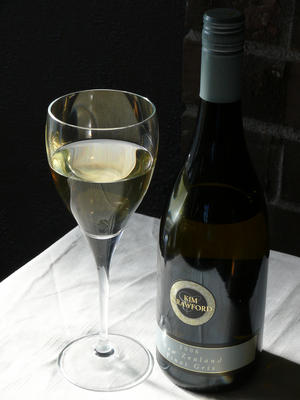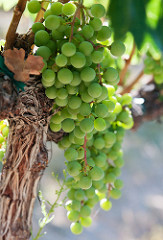![]()
 James Flewellen: Wine & Food Pairing with Classic French Dishes
James Flewellen: Wine & Food Pairing with Classic French Dishes

- Strawberries with red wine3liz4 / Foter / CC BY-NC-ND
| Cassoulet | This depends on the choice of meat in the dish. Try a Chianti or another Tuscan wine, with more savoury notes for deeper-flavoured meats. Or a Barbera, or even a youthful claret if there’s more pork than game in the dish.
|
|
| Choucroute garnie | If you stick to local Alsatian wines for this dish you really can’t go wrong. Use the same wine you’ve used in cooking if possible (typically Riesling), or go for a Pinot Gris.
|
|
| Confit de canard (duck confit) (from Southwest, cooked over a fire in its own fat) |
For this rich dish we have two options. One is to stay local and go for a spicy red wine from the south-west of France – a Tannat from Madiran or a Malbec from Cahors. Alternatively a full-bodied, oaked Chardonnay would also work. The acidity of the white wine will cut through the duck fat nicely. Choose a robust wine with enough body to stand up to the rich flavours though – Meursault from Burgundy, or a Californian pretender.
|
|
| Coq au vin | While red Burgundy is the classic pairing for this dish, a claret will also go very well. Choose one with a few years’ bottle age so the savoury developed notes complement the complex herbs in the sauce.
|
|
| Andouillettes (sausage made with chitterlings) |
A tough dish to pair with on account of its strong flavours and somewhat acquired taste! Both reds and whites could work here. Light reds such as Beaujolais or Chinon will do well to complement the dish without dominating it with too much tannin. On the white side, a light, fresh style is best: perhaps Chablis, or the mountain-air notes of an Arbois from the Jura.
|
|
| Escargots de Bourgogne (snails baked in their shells with parsley butter) |
My favourite pairing for escargots in butter is champagne. The acidity helps out with the fat in the butter but the wine does not overpower the delicate flavours of the snail. A Chablis or other unoaked Chardonnay would also work.
|
|
| Quenelle (flour; butter; eggs; milk; and fish, traditionally pike, mixed and poached) |
The wine pairing depends on the fish used in the quenelle, typically pike. A fish quenelle would go very nicely with a Picpoul de Pinet. The lively, clean flavours of this wine complement fish nicely, and there is great acidity to cut through the butter and eggs.
|
|
| Brandade de morue (puréed salt cod) |
Strongly flavoured fish dishes can be hard to find wine companions for. I’d suggest a very dry Alsatian or German Riesling. Being a bit more adventurous, you could also try a white wine from the Rhône – something based on Marsanne or Rousanne.
|
|
| Bouillabaisse (a stew of mixed Mediterranean fish, tomatoes, and herbs) |
For Bouillabaisse you want a wine that keeps pace with the rich flavours of the dish, but doesn’t detract from them. Keeping local, I would go for a Provençal rosé, or possibly a quality white wine from the south of France. If you’re in the mood for reds – try a light-bodied, acidic wine such as a Cabernet Franc from Chinon or a German Spätburgunder (Pinot Noir).
|
|
| Ratatouille (a vegetable stew with olive oil, aubergine, courgette, bell pepper, tomato, onion and garlic) with white fish |
I go Italian when matching wine to tomato-based dishes. Try a juicy Dolcetto, Barbera or Primitivo. You could also go for Primitivo’s Californian cousin: Zinfandel.
|
|
| Duck à l’orange | Pinot Noir is the classic pairing for duck, however I find the orange in this dish doesn’t quite gel with the flavours in Pinot. Try a Grenache-based wine from the Southern Rhône, such as Châteauneuf-du-Pape. The extra spice in the wine complements the orange.
|
|
| Pot au Feu | A hearty red wine is just the ticket for this meal. I’d go for a Merlot-based Claret from Pomerol in Bordeaux, but wines based on Cabernet Sauvignon, Syrah, Malbec, or Grenache will also do beautifully. Just avoid something that is too jammy in fruit profile.
|
|
| Blanquette de veau | I can’t go past an Alsatian Riesling for this dish. Dry, austere, acidic – the perfect foil for the cream – and the fruit profile won’t obscure the meat.
|
|
| Sole meunière | This dish cries out for a fruity, crisp, light white wine. My pick would be an Albariño from Galicia in Spain.
|
|
| Tournedos Rossini | My classic pairing for this would be a juicy Left Bank claret. To take a step away from the norm, try a Tempranillo-based wine from Ribera del Duero. Unlike its cousins in Rioja, Ribera wines are more robust and full-bodied – ideal for the steak – and usually avoid the sweet-scented American oak.
|
|
| Foie gras (terrine), served with figs or onion jam |
I’ve tried many things with foie gras and really don’t think you can go past the classic Bordelais pairing of Sauternes. The sweetness in the wine works beautifully with the salt in the terrine and the fruit profile goes well with the figs and onion jam.
|
|
| Steack-frites with Béarnaise sauce | Let’s face it steak and red wine go together like a hand in a glove. If you want to emphasise the pepper in the Béarnaise then go for a peppery Syrah from the Northern Rhône or Shiraz from the Barossa.
|
Sign up for Jonell Galloway and James Flewellen’s “Celebrate the Chartres Festival of Lights & Autumnal Equinox with a Food & Wine Tasting Masterclass” in France from September 19 to 22, 2013.
_____________________
Dr James Flewellen is The Rambling Epicure wine columnist. James is a biophysicist at the University of Oxford. Originally from New Zealand, James learned his trade in taste through the Oxford Blind Wine Tasting Society, of which he was the President from 2010-2012. During his term, he represented Oxford at many international blind tasting competitions – twice winning the prestigious ‘Top Taster’ Award in the annual Varsity blind tasting match against Cambridge University and captaining winning teams in competitions throughout Europe.
James runs wine education courses in Oxford through the Oxford Wine Academy and is completing the WSET Professional Diploma in Wine and Spirits. He is the founder of The Oxford Wine Blog and co-author of the forthcoming book: The Concise Guide to Wine and Blind Tasting.
Related articles

|
|

























